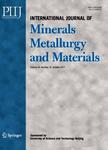Hydrogen effect on the mechanical behaviour and microstructural features of a Fe-Mn-C twinning induced plasticity steel
机械行为和 Fe-Mn-C twinning 的微结构特征上的氢效果导致了粘性钢作者机构:Steel InstituteRWTH Aachen UniversityIntze-str.1Aachen 52072Germany Max-Planck-Institut für Eisenforschung GmbHMax-Planck-Straße 1Düsseldorf 40237Germany NLMK EuropeEutelis-Platz 2Ratingen 40878Germany
出 版 物:《International Journal of Minerals,Metallurgy and Materials》 (矿物冶金与材料学报(英文版))
年 卷 期:2021年第28卷第5期
页 面:835-846页
核心收录:
学科分类:08[工学] 080502[工学-材料学] 0805[工学-材料科学与工程(可授工学、理学学位)]
主 题:twinning induced plasticity steel hydrogen mechanical behaviour dislocation twinning electron channelling contrast imaging
摘 要:The influences of hydrogen on the mechanical properties and the fracture behaviour of Fe-22Mn-0.6C twinning induced plasticity steel have been investigated by slow strain rate tests and fractographic *** steel showed high susceptibility to hydrogen embrittlement,which led to 62.9%and 74.2%reduction in engineering strain with 3.1 and 14.4 ppm diffusive hydrogen,*** fracture surfaces revealed a transition from ductile to brittle dominated fracture modes with the rising hydrogen *** underlying deformation and fracture mechanisms were further exploited by examining the hydrogen effects on the dislocation substructure,stacking fault probability,and twinning behaviour in pre-strained slow strain rate test specimens and notched tensile specimens using coupled electron channelling contrast imaging and electron backscatter diffraction *** results reveal that the addition of hydrogen promotes planar dislocation structures,earlier nucleation of stacking faults,and deformation twinning within those grains which have tensile axis orientations close to//rolling direction and//rolling *** developed twin lamellae result in strain localization and micro-voids at grain boundaries and eventually lead to grain boundary decohesion.




